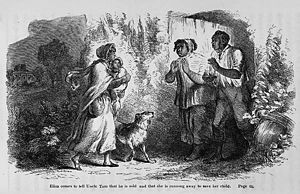“Uncle Tom’s Cabin” Published This Date in 1852
Share
Explore Our Galleries
Breaking News!
Today's news and culture by Black and other reporters in the Black and mainstream media.
Ways to Support ABHM?
Uncle Tom’s Cabin; or, Life Among the Lowly is an anti-slavery novel by American author Harriet Beecher Stowe. was the best-selling novel of the 19th century and the second best-selling book of that century, following the Bible.
It is credited with helping fuel the abolitionist cause in the 1850s. The book and the plays it inspired helped popularize a number of stereotypes about black people. These include the affectionate, dark-skinned “mammy”; the “pickaninny” stereotype of black children; and the “Uncle Tom”, or dutiful, long-suffering servant faithful to his white master or mistress. In recent years, the negative associations with Uncle Tom’s Cabinhave, to an extent, overshadowed the historical impact of the book as a “vital antislavery tool.”
The Civil War led to a brief period of freedom known as the Reconstruction Era.










Comments Are Welcome
Note: We moderate submissions in order to create a space for meaningful dialogue, a space where museum visitors – adults and youth –– can exchange informed, thoughtful, and relevant comments that add value to our exhibits.
Racial slurs, personal attacks, obscenity, profanity, and SHOUTING do not meet the above standard. Such comments are posted in the exhibit Hateful Speech. Commercial promotions, impersonations, and incoherent comments likewise fail to meet our goals, so will not be posted. Submissions longer than 120 words will be shortened.
See our full Comments Policy here.